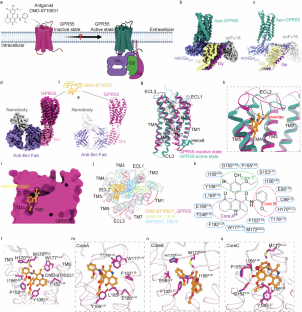配体识别和激活 GPR55 的结构基础
IF 28.1
1区 生物学
Q1 CELL BIOLOGY
引用次数: 0
摘要
亲爱的编辑,人类 G 蛋白偶联受体 55(GPR55)是一种孤儿 GPCR,被称为非典型大麻素受体,即 CB3R。2 有趣的是,据报道利莫那班和 AM251 等 CB1R 拮抗剂也对 GPR55 具有活性,但不同实验室关于利莫那班对 GPR55 的作用的报道并不一致。与主要与 Gi 蛋白偶联的 CB1R 或 CB2R 不同,4 GPR55 激活后可通过与 G12/13 或 Gq 蛋白偶联诱导多种细胞反应。2,3 然而,最近的研究表明,溶血磷脂酰肌醇(LPI)及其 2-arachidonyl 类似物而非内源性大麻素可能是 GPR55 的内源性激动剂。GPR55 主要在脊髓和大直径背根神经节(DRG)中表达,据报道参与调节痛觉感受器的兴奋性和轴突生长。这些生理和病理生理过程凸显了 GPR55 的治疗潜力。值得注意的是,有报道称 GPR55 在某些组织中与 CB1R 或 CB2R 形成异二聚体,这增加了其药理特征的复杂性。本文章由计算机程序翻译,如有差异,请以英文原文为准。


Structure basis of ligand recognition and activation of GPR55
求助全文
通过发布文献求助,成功后即可免费获取论文全文。
去求助
来源期刊

Cell Research
生物-细胞生物学
CiteScore
53.90
自引率
0.70%
发文量
2420
审稿时长
2.3 months
期刊介绍:
Cell Research (CR) is an international journal published by Springer Nature in partnership with the Center for Excellence in Molecular Cell Science, Chinese Academy of Sciences (CAS). It focuses on publishing original research articles and reviews in various areas of life sciences, particularly those related to molecular and cell biology. The journal covers a broad range of topics including cell growth, differentiation, and apoptosis; signal transduction; stem cell biology and development; chromatin, epigenetics, and transcription; RNA biology; structural and molecular biology; cancer biology and metabolism; immunity and molecular pathogenesis; molecular and cellular neuroscience; plant molecular and cell biology; and omics, system biology, and synthetic biology. CR is recognized as China's best international journal in life sciences and is part of Springer Nature's prestigious family of Molecular Cell Biology journals.
 求助内容:
求助内容: 应助结果提醒方式:
应助结果提醒方式:


